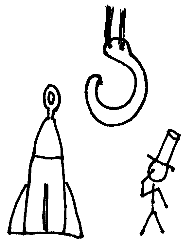3. - Two Ropes Are Better Than One
What do you do when you want to lift a 64 tonne missile that you bought from a country that doesn't do drop tests on its ordnance? Especially when USA designed air-to-air missiles are known to have failed UK one metre drop tests?
US Dod/UK MOD circa 1990
The US considered that a 100% safety factor was adequate when lifting its missiles so procured a crane with a capacity of 125 tonnes. The UK authorities approached the problem from a risk perspective, i.e. that the risk of a crane failure should be vanishingly small. The chosen European crane manufacturer asserted that no single-lifting chain solution was possible and that two independent lifting chains would be needed .A single hook would, however, be OK. Consequently the delivered solution was effectively two 125 tonne capacity cranes in parallel, hoisting a single hook, of 250 tonne capacity.

Being a European manufacturer of cranes the hook was chosen to have a German DIN profile rather than a US ANSI pattern. Clearly the UK would now have a crane that was twice as strong as the US one and under no credible circumstance would it ever drop the US-supplied ordnance that had never, (and never would be), drop tested.
It was around this time that it was pointed out that although the UK crane didn't interface with the flight hardware (Class 1) but with an adapter (Class 2) and that made it Class 3, and not restricted to being of US manufacture, it did have to conform to the US interface drawings. Unfortunately there is no way that a hook produced to DIN can interface with a bail made to ANSI, especially when the DIN hook is twice the size of the ANSI bail apperture.

Sometimes things can be too strong.
